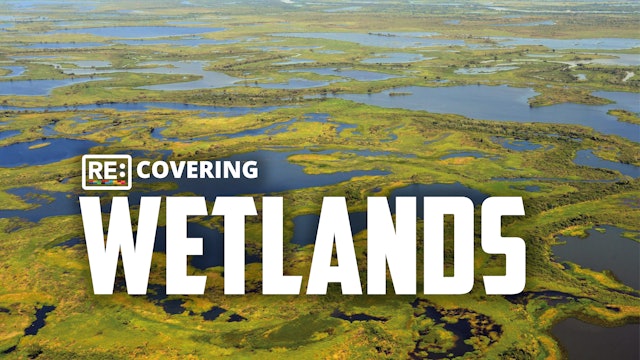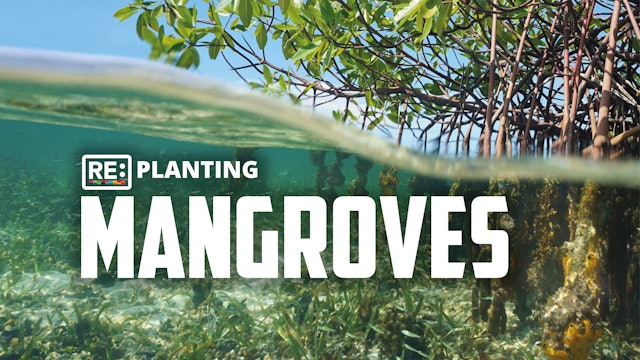RE:TV
-
RE:TV Reconnecting Globally
19 items
RE:TV series highlights some of the inspiring global innovations and ideas that are emerging in response to the climate and biodiversity crisis.
RE:TV was announced at the World Economic Forum at Davos in January 2020 by His Majesty King Charles III (then HRH The Prince of Wales) alongside the ...
-
RE:TV Research and Scientific Innovations
12 items
RE:TV highlights some of the most inspiring scientific innovations and ideas that are emerging in response to the climate and biodiversity crisis.
RE:TV was announced at the World Economic Forum at Davos in January 2020 by His Majesty King Charles III (then HRH The Prince of Wales) alongside th...
-
Retrieving Plastic
More than two-thirds of plastic in our oceans comes from rivers and canals. Preventing this plastic waste reaching the sea is essential if we are to protect marine environments and biodiversity.
The Great Bubble Barrier is an innovative approach to capturing fugitive plastic in waterways, develo...
-
Repackaging Naturally
Notpla have created a home compostable alternative to plastic which is derived from seaweed. An abundant, diverse organism found all over the world, seaweed can be cultivated without competing for land with food crops, doesn’t need fresh water or fertiliser, and actively contributes to de-acidify...
-
Encouraging Resilience
The Royal Botanic Gardens, Kew is home to over 350 scientists whose mission is to halt biodiversity loss and to protect plants and fungi for people and planet.
Kew's patron, HRH The Prince of Wales, brought leaders from the business community to the Royal Botanic Gardens so they could hear first-... -
Recovering Wetlands
As well as being among the most biodiverse ecosystems on earth, healthy wetlands protect us from flooding, help clean water of pollutants, and sequester significant amounts of carbon. But these unique ecosystems are under threat across the world – over the past 300 years, a staggering 87% of the ...
-
RE:TV introduces innovations for our Oceans
-
Reconsidering Agriculture
With an estimated 25% of greenhouse gas emissions coming from our food system, rethinking our approach to agriculture is essential if we are to create a sustainable future. By working in harmony with nature, regenerative agriculture can provide more nutritious food at the same time as reducing em...
-
Reconnecting Ecosystems
Despite making up only around 5% of the world’s population, indigenous people protect an estimated 80% of the planet’s remaining biodiversity.
The Ngarrindjeri have lived near Lake Albert in Coorong National Park in South Australia for generations, but the area’s unique wetlands ecosystem is unde... -
Refuelling Aviation
Using bacteria to create Sustainable Aviation Fuel from captured carbon
With 2.5% of global CO2 emissions generated by the aviation sector and 100 million gallons of jet fuel used each year by commercial airlines, decarbonising aviation fuel is essential if we are to achieve a Net Zero future.
Ba... -
New Series from RE:TV
In this second offering RE:TV highlights some of the inspiring innovations and ideas that are emerging in response to the climate and biodiversity crisis.
RE:TV was announced at the World Economic Forum at Davos in January 2020 by His Majesty King Charles III (then HRH The Prince of Wales) along... -
Reinvigorating Crops
Plants are essential to human survival, but the climate and biodiversity crisis means that 40% of all plants are facing extinction, and many of the food crops we rely on are struggling to adapt to the changing environment. Finding ways of helping crops become more resilient to extreme conditions ...
-
Reactivating Chemicals
New Iridium is the Carbon-negative chemical manufacturing inspired by photosynthesis.
The chemicals industry generates trillions of dollars of revenue globally, producing a wide range of products from packaging and paint to food and pharmaceuticals. However, many of the manufacturing processes i...
-
Reabsorbing Carbon
ReTV looks aft accelerating carbon capture from natural chemical weathering. With more than 2 trillion tonnes of excess carbon dioxide in the atmosphere today, we need to accelerate efforts to capture existing #CO2 as well as reduce our emissions.
The oceans are one of the largest carbon sinks on... -
Resilient Wind Power
Zephyr Power's wind turbines near Karachi provide much-needed renewable energy in Pakistan at the same time as restoring local mangroves; a Nature Based Solution that helps reduce the devastating impact of floods in the Indus delta and draw down CO2 from the atmosphere.
Kumayl Khaleeli, CEO of Ze... -
Regenerative Agriculture
With an estimated 25% of greenhouse gas emissions coming from our food system, rethinking our approach to agriculture is essential if we are to create a sustainable future. By working in harmony with nature, regenerative agriculture can provide more nutritious food at the same time as reducing em...
-
Reviving Urban Spaces
The growth of cities around the world is often seen as a significant threat to biodiversity through habitat loss, pollution and rising temperatures. The urban restoration movement is looking to change our experience of cities by reintroducing green spaces to our cities, encouraging wild flowers, ...
-
Resurfacing Heat
Geothermal technology with a key part to play in the clean energy transition. With global demand for energy expected to increase by 50% by 2050, it is essential we find a range of energy sources to replace fossil fuels and support the transition to a clean energy future.
Eavor’s revolutionary ...
-
Restoring Oceans
Marine ecosystems are under threat all over the world. In Belize, the invasive red lionfish has disrupted marine food webs over the last two decades, damaging coral reefs and reducing the productivity of local fisheries. Working with local communities, Blue Ventures have developed a strategy to ...
-
Replenishing the Soil
In the last few decades, farmers around the world have grown dependent on synthetic fertilizers, which in the short term can have a huge impact on the productivity of land, but over a longer period of time deplete soils of natural microorganisms and nutrients, leach nitrogen into waterways, are c...
-
RE:TV Series One Trailer
RE:TV highlights some of the inspiring innovations and ideas that are emerging in response to the climate and biodiversity crisis.
RE:TV was announced at the World Economic Forum at Davos in January 2020 by His Majesty King Charles III (then HRH The Prince of Wales) alongside the Sustainable Mar... -
Reintroducing Buffalo
Kainai knowledge-keeper Leroy Little Bear explains the importance of reintroducing buffalo in their traditional heartlands, where they hold a central place both in the local ecosystem and the culture of indigenous people.
The buffalo is a "keystone species": an eco-engineer which regenerates the...
-
Reseeding Rainforests
Brazil's Xingu Park is the oldest indigenous territory in Brazil. Its 2.6 million hectares provide a home to 16 different tribes. The Rede de Sementes do Xingu brings together over 500 indigenous seed-collectors to gather and disperse native seeds, preserving the Amazon's essential biodiversity w...
-
Replanting Mangroves
Mangroves are one of the most effective natural carbon sinks on earth, storing up to four times more carbon per hectare than rainforests. They are also rich in biodiversity and mitigate some of the most catastrophic local effects of climate change; particularly flooding and coastal erosion. Despi...


























